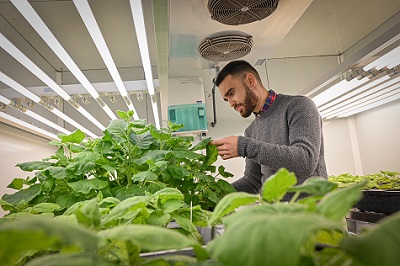Pheromone biofactories
A team from the UPV and the CSIC creates plants that release sex pheromones to fight pests
[ 17/11/2021 ]
A team of researchers from the Universitat Politècnica de València (UPV) and the Spanish National Research Council (Consejo Superior de Investigaciones Científicas, CSIC) has developed genetically modified plants that are capable of producing and releasing insect sex pheromones to deal with pests that affect herbaceous and similar plants, thus reducing the need for using pesticides. These plants have been developed at laboratory level, and the team’s results have been published in the journal Biodesign Research.
In their study, the UPV and CSIC researchers worked with Nicotiana benthamiana as a model plant, which they genetically modified to encode volatile compounds such as moth pheromones, thus turning it into a pheromone biofactory.
"The plant-based bioproduction of insect sex pheromones is an innovative and sustainable strategy for pest control in agriculture. In this study, we have developed transgenic plants that produce two volatile compounds present in many lepidopteran sex pheromone mixtures. These modified plants do not only produce the compounds, they can also release them into the atmosphere. This means that in the future they could be used in pest control techniques such as creating sexual confusion in pest males, or in strategies such as push and pull,” explains Diego Orzáez, a researcher at the Institute of Molecular and Cellular Biology of Plants (UPV-CSIC).
According to Vicente Navarro, a researcher at the Centre for Agricultural Chemical Ecology (CEQA) of the UPV’s Mediterranean Agroforestry Institute, sexual confusion occurs when the concentration of these volatiles in the atmosphere is so high that the male pests have difficulty finding the females that emit the pheromone that attracts them. This prevents or delays copulation, and the reproduction of the species, resulting in a gradual reduction of the population and, therefore, in greater control of the pest.
"So far, these pheromones have been obtained by chemical synthesis, and released into the environment by means of biodispensers in order to attract or confuse the insects. What we have achieved is for a model plant to release the pheromone, which is an unquestionably important step towards crop protection, although it is still too early to transfer these results to the field," adds Orzáez.
To achieve such a transfer, the researchers point out that, among other improvements, it is necessary to increase the emission capacity of the plants. This is why in their study, as a first step they propose to change the plants to be used: they suggest using tobacco or even aromatic plants, which produce many volatiles on their own.
Along with the IBMCP and CEQA teams, researchers from the Slovenian National Institute of Biology (Ljubljana) and the Spanish company Ecología y Protección Agrícola (EPA) have also participated in this study.
Reference
Mateos-Fernández, Rubén, Moreno-Giménez, Elena Gianoglio, Silvia Quijano-Rubio, Alfredo Gavaldá-García, Jose Estellés, Lucía Rubert, Alba Rambla, José Luis Vazquez-Vilar, Marta Huet, Estefanía Fernández-del-Carmen, Asunción Espinosa-Ruiz, Ana Juter?ek, Mojca Vacas, Sandra Navarro, Ismael Navarro-Llopis, Vicente Primo, Jaime Orzáez, Diego Production of Volatile Moth Sex Pheromones in Transgenic Nicotiana benthamiana Plants BioDesign Research https://doi.org/10.34133/2021/9891082
Outstanding news
 Study a degree at the best technological university in Spain
Study a degree at the best technological university in Spain
The Universitat Politècnica de València is ranked number 1 among Spanish technology universities, according to the Shanghai ranking
 Highly Cited Researchers 2025
Highly Cited Researchers 2025
Avelí Corma, Juan Bisquert and Luis Guanter, the international scientific elite with a Universitat Politècnica de València hallmark
 Historic Milestone in Spanish Higher Education
Historic Milestone in Spanish Higher Education
The UPV inaugurates the Beihang Valencia Polytechnic Institute, the first Spanish university center in China
 Study in English
Study in English
The UPV offers eight degrees, 16 master's and 650 courses in English for the 2025-26 academic year
 A Latin Grammy... with the UPV hallmark
A Latin Grammy... with the UPV hallmark
'Music teaches us to listen and live together,' says Rafael Serrallet, Doctor of Music at the UPV, awarded in Las Vegas as the author of the Best Instrumental Album of 2025
 THE Impact Ranking
THE Impact Ranking
The UPV, the Spanish university with the greatest social and economic impact in the world

